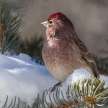
The Black-footed Albatross (Phoebastria nigripes) is a large seabird of the Diomedeidae family North Pacific albatross. Everything except 2.5 per cent of the population are within the Northwest Hawaiian Islands. It is one of three breeding albatross populations that occurs on isolated tropical Islands in the northern hemisphere. Compared to other albatrosses the plumage is brown. Black-footed albatrosses are a species of albatrosses that belong to the tribe Diomedeidae of the order Procellariiformes, together with shearwaters, fulmars, storm petrels and diving petrels. They hold other identifying characteristics. First, they have nasal passages which connect naricorns to their top head.
The albatross nostrils are on the side of the head however. The bills of Procellariiformes are also peculiar in that they are broken into seven to nine horny platelets. Lastly, they produce a gastric oil composed of the wax esters and triglycerides in the proventriculus. Chicks and adults use this as a source of energy-rich food, both against predators and for their long journeys. They may have a salt gland above the nasal passage, which helps desalinate their bodies, taking into consideration the large amount of ocean water they imbibe. Their nose is excreted from a solid, saline solution.
The specific epithet of nigripes derives from two Latin words, "black" meaning niger, and "foot" meaning pes The black-footed albatross is a small member of the albatross family (though still large compared to most other seabirds) which has almost all the black plumage within it. Most adults have white undertail and all adults have white lines under the jaw and around the beak base. When birds mature they get whiter in the centre of the beak. The beak is also black, and the foot. The one we possess is plumage. They measure between 67 and 75 cm, have a wingspan of between 190 and 220 cm, and weigh 2.5–4.2 kilogrammes. The males are heavier than the females, measuring 3.4 kg on average and measuring 3 kg on average. Together with the laysan albatross and the rare short-tailed albatross, black-footed albatross are the northern hemisphere's three remaining albatross populations, as opposed to the rest of the population spread from the southern equator. There are at least 12 established breeding sites, but the isolated Northwest Hawaiian islands have a colonial concentration of 97 per cent of the total population. Their vocalisation varies from shrieks and squeals to bill-claps, whistles, groans and quacks as they compete over milk in court. The blackfooted albatross, as with the rest of his companions, establishes long-lasting pair-bonds that endure for life.
Upon three years of fleeing the birds return to the colony and spend two years building nests, dancing and playing with prospective mates, a tradition obviously emerging to preserve absolute allegiance between the birds as raising an albatross chick is an immense energetic undertaking and a lengthy time of courting for both birds guarantees fidelity to the other. We will continue to reproduce at about seven years, spawning every 2 years. The blackfooted albatross travels through pelagic waters, eating to a lesser degree the larvas of diving whales, crabs, and crustaceans. Similarly, floating waste can be treated as tissues. The blackfooted albatross is considered virtually vulnerable by IUCN, as longline fishing typically needs it. Depending on the 1990 figure, a total of 4,000 are killed annually; other estimates placed the estimate at 8,000, although more recent figures are around 6,200 a year, with most deaths from Taiwanese and Japanese fishing fleets. This is therefore vulnerable to oil and moving items vomiting, thus increasing the distance in the stomach for the chick to be given milk. At last volcanic eruptions on Torishima become a threat.
About the Creator
MB
I am a bird aficionado and really enjoy spotting them them on hikes. I greatly appreciate the variety of birds cross North America and the world. They are amazing and intelligent creatures, each so unique and with a wonderful life.






Comments
There are no comments for this story
Be the first to respond and start the conversation.